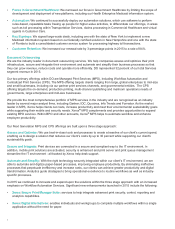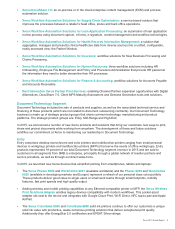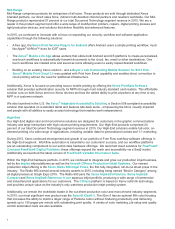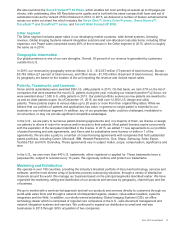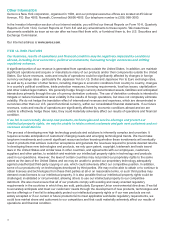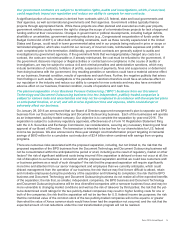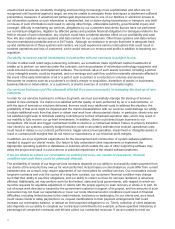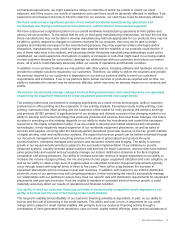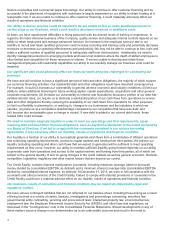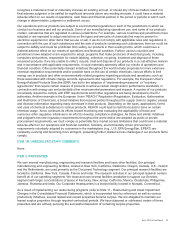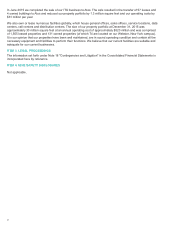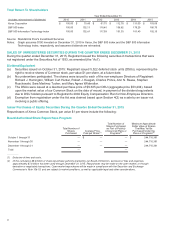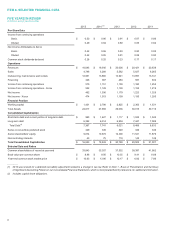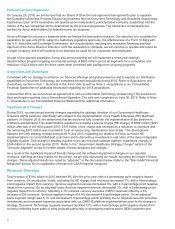Xerox 2015 Annual Report Download - page 34
Download and view the complete annual report
Please find page 34 of the 2015 Xerox annual report below. You can navigate through the pages in the report by either clicking on the pages listed below, or by using the keyword search tool below to find specific information within the annual report.unauthorized access are constantly changing and becoming increasingly more sophisticated and often are not
recognized until launched against a target, we may be unable to anticipate these techniques or implement sufficient
preventative measures. If unauthorized parties gain physical access to one of our facilities or electronic access to
our information systems or such information is misdirected, lost or stolen during transmission or transport, any theft
or misuse of such information could result in, among other things, unfavorable publicity, governmental inquiry and
oversight, difficulty in marketing our services, allegations by our customers and clients that we have not performed
our contractual obligations, litigation by affected parties and possible financial obligations for damages related to the
theft or misuse of such information, any of which could have a material adverse effect on our profitability and cash
flow. We also maintain various systems and data centers for our customers. Often these systems and data centers
must be maintained worldwide and on a 24/7 basis. Although we endeavor to ensure that there is adequate back-
up and maintenance of these systems and centers, we could experience service interruptions that could result in
curtailed operations and loss of customers, which would reduce our revenue and profits in addition to impairing our
reputation.
Our ability to recover capital investments in connection with our contracts is subject to risk.
In order to attract and retain large outsourcing contracts, we sometimes make significant capital investments to
enable us to perform our services under the contracts, such as purchases of information technology equipment and
costs incurred to develop and implement software. The net book value of such assets recorded, including a portion
of our intangible assets, could be impaired, and our earnings and cash flow could be materially adversely affected in
the event of the early termination of all or a part of such a contract or a reduction in volumes and services
thereunder for reasons such as a customer's or client's merger or acquisition, divestiture of assets or businesses,
business failure or deterioration, or a customer's or client's exercise of contract termination rights.
Our services business could be adversely affected if we are unsuccessful in managing the start-up of new
contracts.
In order for our services business to continue its growth, we must successfully manage the start-up of services
related to new contracts. If a client is not satisfied with the quality of work performed by us or a subcontractor, or
with the type of services or solutions delivered, then we could incur additional costs to address the situation, the
profitability of that work might be impaired and the client's dissatisfaction with our services could damage our ability
to obtain additional work from that client or obtain new work from other potential clients. In particular, clients who are
not satisfied might seek to terminate existing contracts prior to their scheduled expiration date, which may result in
our inability to fully recover our up-front investments. In addition, clients could direct future business to our
competitors. We could also trigger contractual credits to clients or a contractual default. Failure to properly transition
new clients to our systems, properly budget transition costs or accurately estimate new contract operational costs
could result in delays in our contract performance, trigger service level penalties, impair fixed or intangible assets or
result in contract profit margins that do not meet our expectations or our historical profit margins.
In addition, we incur significant expenditures for the development and construction of system software platforms
needed to support our clients' needs. Our failure to fully understand client requirements or implement the
appropriate operating systems or databases or solutions which enable the use of other supporting software may
delay the project and result in cost overruns or potential impairment of the related software platforms.
If we are unable to collect our receivables for unbilled services, our results of operations, financial
condition and cash flows could be adversely affected.
The profitability of certain of our large services contracts depends on our ability to successfully obtain payment from
our clients of the amounts they owe us for work performed. Actual losses on client balances could differ from current
estimates and, as a result, may require adjustment of our receivables for unbilled services. Our receivables include
long-term contracts and over the course of a long-term contract, our customers' financial condition may change
such that their ability to pay their obligations, and our ability to collect our fees for services rendered, is adversely
affected. Additionally, we may perform work for the federal, state and local governments, with respect to which we
must file requests for equitable adjustment or claims with the proper agency to seek recovery in whole or in part, for
out-of-scope work directed or caused by the government customer in support of its project, and the amounts of such
recoveries may not meet our expectations or cover our costs. Macroeconomic conditions could result in financial
difficulties, including limited access to the credit markets, insolvency or bankruptcy, for our clients and, as a result,
could cause clients to delay payments to us, request modifications to their payment arrangements that could
increase our receivables balance, or default on their payment obligations to us. Timely collection of client balances
also depends on our ability to complete our contractual commitments (for example, achieve specified milestones in
percentage-of-completion contracts) and bill and collect our contracted revenues. If we are unable to meet our
17


